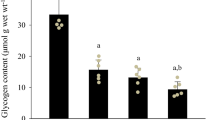Abstract
-
1.
The influence of high-intensity bicycle exercise on the redox level and lactate accumulation in skeletal muscle (m. quadriceps femoris) of man has been investigated. Six subjects exercised to exhaustion at a load corresponding to 100%VO2max.
-
2.
Muscle content of NADH, determined by the bioluminescense technique, increased from (x±SEM) 0.089±0.007 mmol/kg dry wt. at rest to 0.190±0.031 after 2 min of exercise (P<0.05) and to 0.213±0.021 at exhaustion (P<0.05). Values after 2 min exercise and at exhaustion were not statistically different (P>0.05). Muscle lactate was increased 13-fold after 2 min of exercise and 22-fold at exhaustion as compared to the resting value.
-
3.
After 10 min recovery NADH was restored back to the pre-exercise level whereas muscle lactate was still elevated.
-
4.
The increase of muscle NADH during exercise is in contrast to earlier studies on isolated animal muscles, where an oxidation of NADH was observed during contractions. The difference might be due to the experimental model (isolated muscle vs. in vivo) or to the analytical method (qualitative data by reflectance fluorimetri from the surface of intact muscle vs. quantitative data from muscle extracts).
-
5.
Calculations of the cytosolic NADH concentration from the lactate dehydrogenase equilibrium show that 95% or more of the NADH is confined to the mitochondrial compartment. The observed increase of muscle NADH therefore imply that the redox potential of the mitochondria is decreased during intense exercise.
-
6.
The results are in conformity with that local hypoxia in the muscle cell is the mechanism for lactate production during exercise but an alternative explanation could be that the capacity of the respiratory chain to oxidize the formed NADH has been exceeded.
Similar content being viewed by others
References
Bergmeyer HU (1974) Methods of enzymatic analysis. Verlag Chemic, Weinheim, pp 1468–1472, 2045–2059
Bergström J (1962) Muscle electrolytes in man. Scand J Clin Lab Invest 14, Suppl. 68:7–101
Connett RJ, Gayeski TEJ, Honig CR (1984) Lactate accumulation in fully aerobic, working dog gracilis muscle. Am J Physiol 246:H120-H128
Graham T, Sjögard G, Löllgen H, Saltin B (1978) NAD in muscle of man at rest and during exercise. Pflügers Arch 376:35–39
Harris RC, Hultman E, Nordesjö L (1974) Glycogen, glycolytic intermediates, and high-energy phosphates determined in biopsy samples of musculus quadriceps femoris of man at rest. Methods and variance of values. Scand J Clin Lab Invest 33:109–120
Hughes RL, Clode M, Edwards RHT, Goodwin TJ, Jones NL (1968) Effect of inspired O2 on cardiopulmonary and metabolic responses to exercise in man. J Appl Physiol 24:336–347
Jöbsis FF, Stainsby WN (1968) Oxidation of NADH during contractions of circulated mammalian skeletal muscle. Resp Physiol 4:292–300
Kaijser L (1970) Limiting factors for aerobic muscle performance. Acta Physiol Scand, Suppl 346:5–89
Knuttgen HG, Saltin B (1973) Oxygen uptake, muscle high-energy phosphates, and lactate in exercise under acute hypoxic conditions in man. Acta Physiol Scand 87:368–376
Linnarsson D, Karlsson J, Fagraeus L, Saltin B (1974) Muscle metabolites and oxygen deficit with exercise in hypoxia and hyperoxia. J Appl Physiol 36:399–402
Sahlin K (1983) NADH and NADPH in human skeletal muscle at rest and during ischaemia. Clin Physiol 3:477–485
Sahlin K, Harris RC, Nylind B, Hultman E (1976) Lactate content and pH in muscle samples obtained after dynamic exercise. Pflügers Arch 367:143–149
Wendt IR, Chapman JB (1976) Fluorometric studies of recovery metabolism of rat fast- and slow-twitch muscle. Am J Physiol 230:1644–1649
Williamson DH, Lund P, Krebs HA (1967) The redox state of free nicotineamide-adenin dinucleotide in the cytoplasm and mitochondria of rat liver. Biochem J 103:514–527
Author information
Authors and Affiliations
Rights and permissions
About this article
Cite this article
Sahlin, K. NADH in human skeletal muscle during short-term intense exercise. Pflugers Arch. 403, 193–196 (1985). https://doi.org/10.1007/BF00584099
Received:
Accepted:
Issue Date:
DOI: https://doi.org/10.1007/BF00584099




